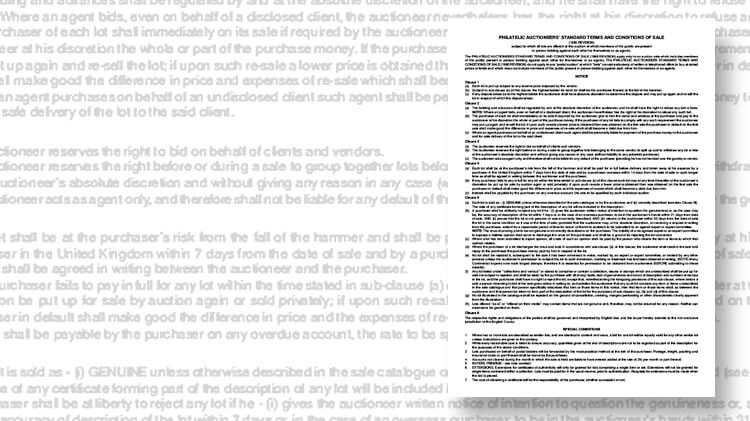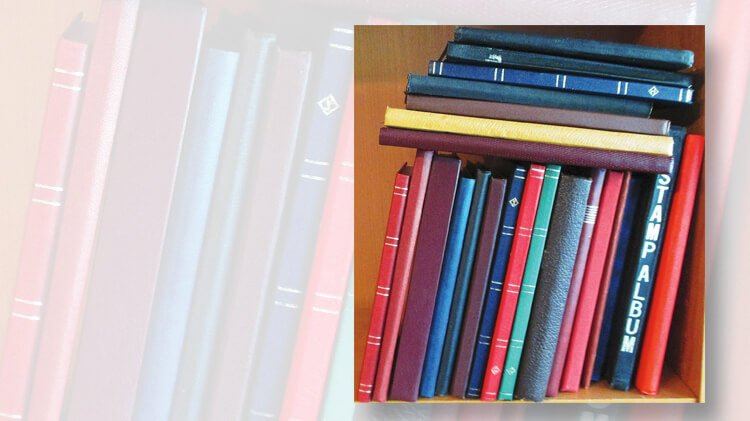Auctions
How to participate in a philatelic auction
By Fred Baumann
Auctions can be a very good way to buy and sell postage stamps and covers, and World Stamp Show-NY 2016 will provide several opportunities.
The experience of taking part in a public auction is challenging, stimulating, occasionally nerve-wracking, often highly productive, and rarely dull (except, perhaps, when you’re waiting for “your lots” to be sold). As with much else in the stamp hobby, auction bidding can handsomely benefit those who do their homework, read attentively, and possess the patience, discipline and temperament to act when opportunity arises.
Needless to say, there’s a good deal more to it than that. Here’s a bit of perspective and some hints to help make stamp auctions enjoyable and productive for you.
Connect with Linn’s Stamp News:
Sign up for our newsletter
Like us on Facebook
Follow us on Twitter
Many collectors regard auctions as highly formal affairs in which rare and valuable stamps change hands, often for remarkable sums. There is some truth to this, because auctions can attract the interest of an international audience of affluent and informed collectors in search of important acquisitions. When a newly discovered rarity or an important recent error surfaces in the philatelic marketplace, it is often at a major public auction where the sale can achieve the greatest exposure and draw the highest price.
But many average American collectors overlook the valuable opportunities that auctions offer them. Sought-after sets and single stamps can sell for a fraction of their usual retail price in an auction — or for multiples of that price, if the stamp is truly exceptional in some way. The point is that most philatelic auctions will have items you want, at prices you will find appealing.
You Need Not Be Rich to Bid
Perhaps the best and most often overlooked auction opportunity awaits beginning or returning adult collectors. For them, stamp auctions can be the least expensive way to get started with a new country or topic by buying someone else’s well-begun collection. When such collections have had some of their most valuable stamps removed to be auctioned in separate lots, they are often referred to as a collection “balance” or “remainder.” They often consist of stamps mounted or hinged on album pages, or tucked away safely in a stock book.
If you know what you’re looking for in terms of quality, period and condition, and are willing to spend the time you’ll need to carefully inspect their contents before the sale, larger lots like these can be unbeatable bargains. They are typically priced from several hundred to several thousand dollars, but often represent enormous savings in both time and money over the cost and chore of buying a collection stamp by stamp, or set by costly set.
That is the first of a few common-sense rules in obtaining the best results as an auction buyer. Lots, and especially large lots, reward meticulous personal examination. For those who bid on single stamps or sets from a catalog, whether by mail, by phone or digitally over the Internet, that inspection may be limited to the description and image of the item that are presented.
Read the Fine Print
Because most bidders in a philatelic auction make their selections and place their bids at a distance, it is absolutely essential that buyer and seller alike agree to what rules will govern the auction. As a bidder, it is your responsibility to read and familiarize yourself with these terms and conditions (as such rules are called). Most are similar, but there are many different variations from one auction firm to another, some of which may be critically important.
Any bid you place is subject to these rules. Any request you may have that is an exception to these rules must be clearly communicated to the auctioneer in writing before the sale, and it is the auction firm’s prerogative to accept or reject your request. Much of the terms and conditions are simple and straightforward: the intervals you must use between bids you make in the sale, for example. But others can be more complicated, such as the rules regarding requests for expertizing of an item purchased at auction which can include who pays; how long it will take; who the firm regards as a qualified and desirable expert; and so forth. Not all auction firms have the same rules or the same preferences.
In auctions, as in any philatelic transactions, one other piece of small print that can be extremely useful to locate is the firm’s affiliation with national organizations that have a code of ethics — a general statement of the values shared by its members and honored in how they conduct their business. Examples of these include the American Philatelic Society and the American Stamp Dealers Association.
A meaningful code of ethics tells you what you can expect, and outlines options for filing a grievance should you feel that redress is owed to you.
Reviewing the Auction
Whether you view lot listings online or in an elegantly produced catalog, the next step toward taking part in an auction is finding what you want. In many stamp auctions, United States stamps and covers appear first in chronological order, followed by countries of the world in alphabetical order with the lots in order numerically according to age (oldest to youngest) or catalog number (lowest to highest, followed by back-of-the-book stamps such as airmail or postage due stamps).
Large lots may be groups with their country, region or subject, or may be grouped together at the end of the sale with all the other larger lots.
Typically, individual lots are described using a variety of symbols and abbreviations to save space. A helpful key to these appears prior to the start of the auction listings at the beginning of the catalog. In Internet auctions, if clarification is required, you can usually ask a question quickly by email.
Examine carefully all images of lots on which you plan to bid. In the unlikely event that you detect what appears to be a defect or blemish, be sure your inquiry about these is answered before you bid. Auction houses are not responsible for taking back returns of any lots in which flaws are clearly visible and were accurately described.
Calculating Your Bids
Now that you’ve chose items you’d like to bid on, how do you decide how much to bid? If you are bidding by mail and will not be present when the gavel comes down, there are a variety of tools you can use. Nearly all auction firms list either an estimated retail price or a current catalog value with each lot to help you decide what to bid. There are certainly exceptions, but frequently these are somewhat higher sums than the winning bid, even including the buyer’s premium you pay on each lot you win.
You can use the prices you’ve seen in the marketplace, including at dealers’ bourses, stamp shows and in other sales, to help you decide what to bid. If it’s a catalog-listed stamp in fine-to-very-fine (f-vf) condition, you can bid low knowing that other examples in comparable condition are often offered for sale. If it’s an old envelope with a postmark you’ve never seen before, or a stamp with a plate number and exceptional centering — items you may never see again — you will probably succeed more often by bidding higher.
The other important consideration in bidding is the overall total of your bids. If you are bidding accurately, you are unlikely to get every item you bid on. Other bidders will have a higher opinion of the stamp or simply want it more than you do, and will outbid you on some lots. But the possibility exists that every lot you bid on could sell to you, so you should limit your total bids to an amount you can afford to pay. (This recommendation is based on hard-won personal experience with a badly overheated VISA card in my younger days. I did not repeat my error!)
If you have the opportunity, by all means attend the auction and bid in person —and, as this list shows — that’s a marvelous opportunity you’ll have a number of times during World Stamp Show –NY 2016.
Stamp auctions are exciting and suspenseful. They can make your heart race and your pulse quicken. That’s why I strongly urge you to decide as far in advance as possible what you are willing to pay, and what you are not willing to pay, for each and every item you plan to bid upon.
This is absolutely vital if you want to keep from overspending. It is easy to become almost obsessed with some wonderful item and resist what you’ve learned by leaving your hand in the air until you hear “Sold!” Don’t do it.
And don’t give in to remorse on lots you don’t win. Many such collectors grumble, “I was outbid, but I could have won that lot for just another $10!” They know no such thing. The winning bidder beat you by $10, but you have no idea how high he might have gone to get it. By the same token, you have no idea when he might have decided to drop out — perhaps leaving you with a cover that cost you $90 more than you had planned!
This is why determining what items are, and are not, worth ahead of time is an important exercise. If you don’t get one lot within your budget, that should leave you the wherewithal to get another. I guarantee you that you’ll still find the experience exciting — and the trip home much more enjoyable, too.
More about what's going on at World Stamp Show-NY 2016:
Some tips for enjoying your stay in New York City during World Stamp Show-NY 2016
Are you planning to attend WSS-NY 2016? Share your show experiences with Linn’s
Exciting opportunities await visitors to World Stamp Show-NY 2016
MORE RELATED ARTICLES
Headlines
-
US Stamps
Oct 7, 2024, 12 PMVasiliauskas named president of Mystic Stamp Co.
-
US Stamps
Oct 6, 2024, 5 PMApgar souvenir card available
-
US Stamps
Oct 6, 2024, 4 PMFirst Continental Congress and U.N. stamps receive Scott catalog numbers
-
World Stamps
Oct 5, 2024, 1 PMCanada Post continues Truth and Reconciliation series







